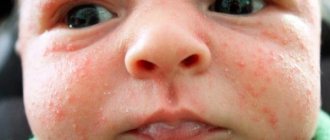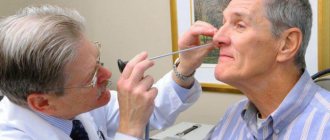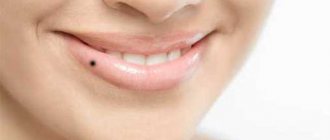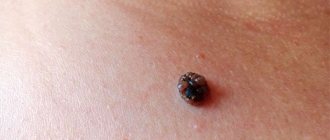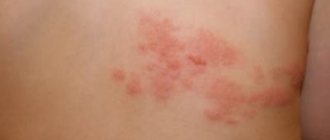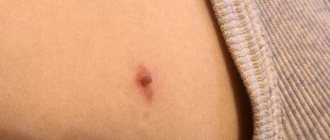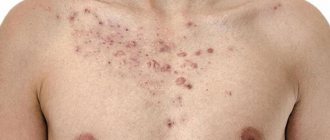Nevi are benign skin growths that are brown or beige in color and are the result of the accumulation of melanin in the cells of the dermis. They do not pose any particular danger, unless, of course, they are subjected to frequent injuries and prolonged exposure to ultraviolet radiation. Dermatologists recommend not touching such growths if they do not cause physical or aesthetic discomfort.
But what does it mean if a black mole forms on the body? Isn't this a dangerous sign and a reason to immediately consult a doctor? Such neoplasms are not to be trifled with, and it is better not to try to remove them yourself. There are several possible options for why a dark nevus forms or a black dot appears on a mole, and we will consider them in as much detail as possible.
In the area of special attention
It's easy to miss melanoma developing from a mole. And pigmented areas of the skin are at risk of epithelial degeneration at the cellular level. The sharp growth of a nevus should be a warning first of all.
Additional evidence of cell transformation into cancer is:
- Blurring boundaries;
- Pain on palpation;
- Color change;
- The appearance of bleeding;
- Leakage of fluid from a mole.
Important!
The appearance of such signs is grounds for immediately visiting a doctor!
Failure to consult a specialist in a timely manner can cause the progression of cancer and the development of metastases.
How to remove wen on the face at home
At home, you can try some non-surgical methods for treating wen in various ways. It is important to take into account the characteristics of the skin, the general condition and the prevalence of fatty nodules.
How to get rid of lipoma on the face at home using folk remedies
Among folk remedies, there are many recipes for the non-surgical removal of small fatty deposits. Alternative medicine recipes are aimed at increasing blood flow in the area of tumors in order to facilitate their absorption.
Popular recipes include:
- Compress based on golden mustache . A fresh leaf is cut, the damp surface is placed on the pathological focus and fixed with a plaster. It is better to do the compress at night.
- Garlic and onion compress . A few cloves of garlic and half an onion are crushed in a blender, a few drops of propolis are added. The resulting slurry is applied locally to the wen, covered with a small piece of bandage and secured with an adhesive plaster. The compress is kept for several hours until completely dry.
- Egg white . The protein mass is used to treat areas of skin with wen until completely dry. For effectiveness, you can add aloe juice and tea tree oil to the protein.
- Cauterization with celandine juice . The stem of the plant is cut with a sharp knife at an angle and the resulting juice is locally treated with areas with fatty bumps. The course of treatment is 7-14 days.
Additionally, a pimple on the face is treated with bee products, animal fat, cinnamon or mustard powder. The course of treatment is long, reaching several weeks. If allergic reactions occur, the course should be stopped and an alternative method of treatment should be chosen.
How to remove a wen on the face at home with a needle and is it possible to do this?
Clinicians do not recommend mechanical removal of fatty growths on the face at home for several reasons:
- Risk of infection;
- Inability to remove the capsule;
- The need to fix mobile tumors.
The inability to remove the capsule leads to recurrence of wen and the formation of new nodules on the skin. The face contains many blood vessels and nerve plexuses. Inadequate removal can lead to facial paralysis, distortion of facial features and other irreversible consequences. For the same reason, doctors do not recommend removing even ordinary acne at home.
How to remove wen on the face under the eye
It is unacceptable to remove a fatty tumor under the eye yourself. Mechanical injury leads to serious damage to the skin, the formation of rough scars, and damage to the choroid plexuses.
If a papilloma has grown on a mole
The appearance of papillomas is associated with human infection with HPV (human papillomavirus). Additional differentiated studies are recommended if papilloma appears on a mole. The main purpose of such tests is to establish the benignity of the neoplasm, as well as to exclude the development of dysplasia.
Depending on the research results, a treatment or observation program is developed.
It includes three variations:
- Remaining under observation - in the absence of signs of degeneration;
- Mole removal – if dysplasia is detected;
- Fighting melanoma: excision of the tumor, administration of chemotherapy or radiation.
Symptoms
The symptoms of pimple formation in the tissues of a mole are varied. Most often, the problem affects nevi in those areas of the body where the largest number of sebaceous glands are concentrated (back and face).
The first sign that a pimple should appear is some pain when touched, tissue compaction. Next, a cone-shaped nodule of a typical reddish color appears, and with the development of the inflammatory reaction it will increase in size. When the pimple matures, a point with purulent contents will begin to be visible inside. Gradually, the papule will open, the contents will come out, and the pimple will crust over until the tissues are completely healed.
In the case of ordinary blockage of the sebaceous gland, no pronounced symptoms (besides mild pain when touched) are observed.
If the mole turns black
In addition to the problem of papillomas growing on a nevus, a change in its color can also be alarming. Many people are frightened by the black or dark brown tint of a mole. Don’t panic, blackening of a nevus does not always indicate the process of degeneration. Here are the signs:
- Color blurring - the appearance of lighter and darker areas;
- Painful sensations in the area of the mole;
- Bleeding and crusts that form on the surface of the mole;
- The appearance of separated particles;
- Swelling of the nevus;
- Fuzzy outline;
- Inflammation and redness.
The presence of at least one of the listed signs is a reason to immediately consult a doctor and begin treatment.
Diagnostic features
If a mole changes color to a darker color, then first you can consult a dermatologist. Especially if you do not have the opportunity to undergo an initial examination by an oncodermatologist.
To begin with, the doctor conducts a detailed survey to determine whether there are any complaints about the presence of inflammatory pain and other alarming symptoms. He must find out whether the black mole was on the back or other part of the body before, or appeared recently. What was its size, does it bleed, how often does it become inflamed, etc.
Next, a detailed study of the growth must be carried out using a magnifying glass. Although the eye of an experienced specialist can detect suspicious features of a neoplasm even without a lens. But this is not enough.
After a visual examination of a black dot on the body, similar to a mole, the doctor must make a preliminary diagnosis, and then prescribe a biopsy. This procedure is the most informative in such a situation. A piece of tissue from the surface of the neoplasm is selected using a scraping or a special needle and sent for microscopic (histological) examination. The results may be as follows:
- A mole with black spots is benign. In this case, the option of removing it, if the patient himself wants it, is selected together with the attending physician.
- The strange mole has not yet begun to degenerate, but atypical cells have already been discovered. Such a tumor is removed urgently to prevent the development of skin cancer.
- A black mole on the back is melanoma. This is the most dangerous option, requiring immediate medical intervention to avoid dangerous complications.
Thus, we figured out why dark moles on the body are dangerous, and what properties they may have - benign or malignant. Now let’s briefly consider options for solving the problem, taking into account the characteristics of the skin growth.
Causes of malignancy
All factors that provoke the transformation of mole cells into cancerous ones are conventionally divided into controllable and uncontrollable. Controllable factors include:
- Injury to formations;
- Prolonged exposure to the sun;
- Visit to the solarium.
Uncontrollable causes of malignancy include:
- Sunburn received in childhood;
- Freckles;
- A large number of benign nevi;
- Genetic predisposition - having relatives suffering from melanoma.
Kinds
The cellular composition of wen is quite diverse. In traditional medical practice, the following types are distinguished:
- Lipofibroma. A soft neoplasm consisting mainly of adipose tissue.
- Fibrolipoma. Unlike the first type, it is quite dense. The reason for this is the presence of not only fat cells, but also connective tissue.
- Myolipoma. The composition of this wen includes muscle fibers.
- Angiolipoma. It is characterized by the presence of a large number of vessels in the tumor.
- Myelolipoma. Quite a rare occurrence. Consists of fat and hematopoietic cells. Typically appears in the adrenal glands and pelvic tissue.
Therapy for papilloma that has grown on a mole
The treatment protocol for a growth on a nevus is a set of measures:
- Taking a biopsy using local anesthesia (the size of the tissue for examination is two millimeters or more);
- If the benignity of the nevus and growth is confirmed by histology, the patient remains under observation;
- If dysplasia (superficial melanoma) is detected, the neoplasm must be removed immediately.
Possible complications
The nevus began to harden and a round thickening formed under it - this indicates the development of an inflammatory process in the dermis, improper functioning and distribution of subcutaneous fat, disturbances in metabolic processes, and hormonal imbalances.
Thickening of the dermis under nevi indicates the development of superficial malignant tumors - sarcoma. Such neoplasms are voluminous. In the initial stages they do not cause discomfort to the patient; they gradually decompose and become inflamed. The growth of the skin under the tumor is the first signal of the development of a cancerous tumor - melanoma.
The lump under the mole should be examined by a doctor. Malignant cells penetrate deep into the body, spreading through the lymph nodes into organs and systems.
Wen on the face causes a lot of problems not only for women, but also for men. The spread of white nodules protruding above the surface of the skin causes a serious aesthetic defect, including the development of psychological problems. Wen on the face requires high-quality removal to avoid infection, damage to nerve roots, and the formation of rough scars. By themselves, lipomatous nodes on the face do not pose a potential cancer risk. With the generalized spread of tumors on the face, normal cell regeneration is disrupted, and it is difficult to return the skin to its original purity and elasticity without professional methods.
Characteristic signs of melanoma
The first signs of the process of degeneration of nevus cells into an oncological tumor were indicated above. As for the classification of melanomas, sometimes even a specialist can establish a diagnosis without additional clinical studies. The following basic types of skin cancer are distinguished:
- Dysplasia or superficial melanoma is the most common cancer;
- Nodular melanoma is an aggressive type that appears as a lump on the skin;
- Lentigo is a cancerous formation located on the head and neck of elderly people;
- The subungual variety attacks the epithelial tissue under the nail plate.
Important!
Any changes in the appearance of the nevus are a reason to contact the clinic.
Timely seeking medical help will allow you to diagnose the pathological process in the early stages and stop its development. Without active therapeutic measures, melanoma quickly metastasizes.
Type of malignant neoplasms
The skin is one of the most complex structures of the human body. Under the influence of various factors, various malignant tumors can form on the surface of the skin. According to statistics, the two most common types of cancer are carcinoma and melanoma. Each of these pathologies has its own key features and forms of development.
Carcinoma has two distinct forms, called basal cell and squamous cell. The reason for the appearance of this pathology is prolonged exposure to sunlight on the skin. According to experts, this disease is most often observed in patients whose age exceeds forty years. Carcinoma is considered to be a curable disease, provided that the pathology is detected in a timely manner.
Basal cell carcinoma is a disease better known by the abbreviation basal cell carcinoma . This type of cancer is considered one of the most common. Tumor formation occurs under the influence of atypical dermal cells. Basalioma has the appearance of nodules with a dense structure.
Prevention of melanoma
Doctors give the following recommendations to prevent the process of malignancy:
- Reduce and, if possible, prevent injury to the neoplasm;
- Avoid exposure to the sun during periods of increased activity;
- Use a cream with a sun protection factor of more than 20;
- Wear T-shirts or shirts with sleeves;
- Protect your head with a Panama hat, cap, hat;
- Undergo an annual preventive examination.
The location of melanomas differs in men and women. In women, the lower legs become the danger zone. The cause is hair removal on the legs. For men, the problem area is the back. This is due to exposure to direct sunlight. Men often go without shirts or T-shirts. Regular preventive examination ensures diagnosis of the early stages of the disease.
Be healthy and remember: your health is in your hands. Attentive attitude to your body, preventive examinations and compliance with doctors’ recommendations will help prevent the development of serious pathology.
Traditional treatment
The main task when a pimple appears is to keep the affected area clean and prevent infection. Treatment involves the following methods:
- You can dry the formation and speed up the regeneration process using ethyl alcohol. A cotton swab is moistened in liquid and applied to the area of inflammation for 5 minutes. It is not worthwhile to completely treat the entire mole and the skin around it. The procedure is repeated every 4 hours.
- For drying and disinfection, you can use iodine - it is applied pointwise to the purulent head of the pimple itself.
- If the pimple is a bite, then it is important to relieve itching as a factor in nevus injury. To do this, the area is treated with boric alcohol diluted with water in a ratio of 1 to 3. It is allowed to apply the special product “Psilo-balm” or any other product with an antihistamine effect.
It is prohibited to treat with hydrogen peroxide! This substance has a pronounced oxidizing effect and can affect the nevus itself.
If the development of a pathological process in a mole is suspected, the doctor will recommend its removal using one of the well-known methods - cryodestruction, laser excision, radio wave cauterization, etc.
Folk remedies
There are a number of folk remedies that are effective for eliminating acne:
- Chamomile flowers. The raw material is brewed in hot water in a standard proportion - a tablespoon per glass. The product is infused for two hours in a thermos, filtered and used to wipe the inflamed area 3 times a day.
- Plantain. Fresh leaves are washed in clean water, dried to remove excess moisture and the juice is extracted from them (you can pass it through a meat grinder, and squeeze out the resulting pulp with gauze folded in several layers). Pure juice is used to wipe the pimple in the morning and evening.
- Elecampane. The brewed herb is filtered and used to treat the nevus 2-3 times during the day.
- Baking soda. To relieve itching from a bite, a thick mixture of baking soda and water can be applied to the pimple. In this case, it is important to be careful and not to make rubbing movements, otherwise you can damage the formation.
The main rule in treatment remains unchanged - it is prohibited to mechanically influence the formation, otherwise you can only make it worse.

